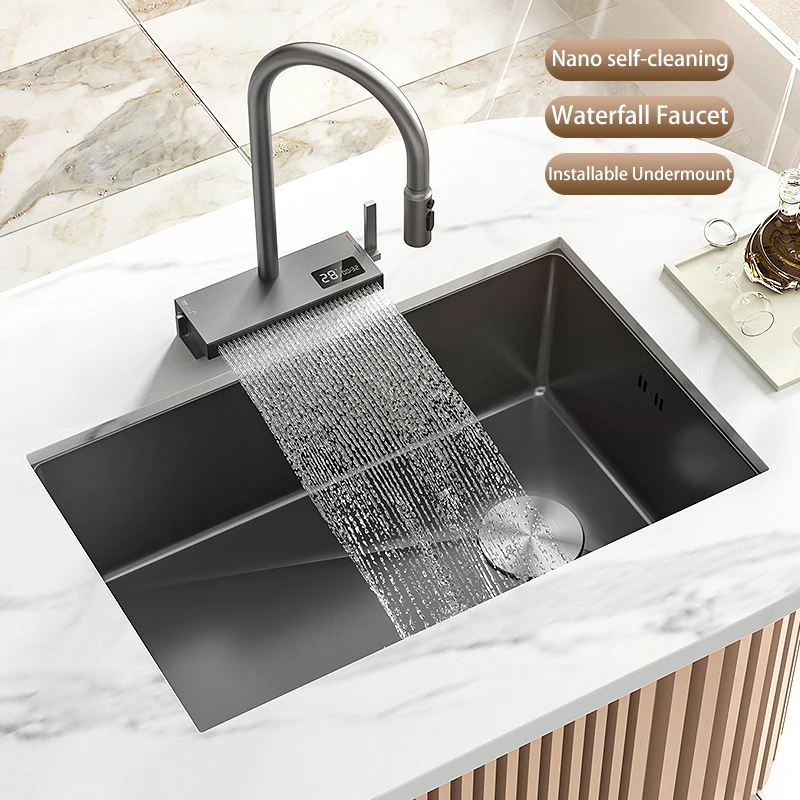Introduction of drop in stainless steel kitchen sinks
Drop-in stainless steel kitchen sinks are a popular choice in modern kitchens. They offer a blend of durability, aesthetics, and functionality. This guide explores everything you need to know about drop in stainless steel kitchen sinks, including their benefits, installation process, and maintenance tips.
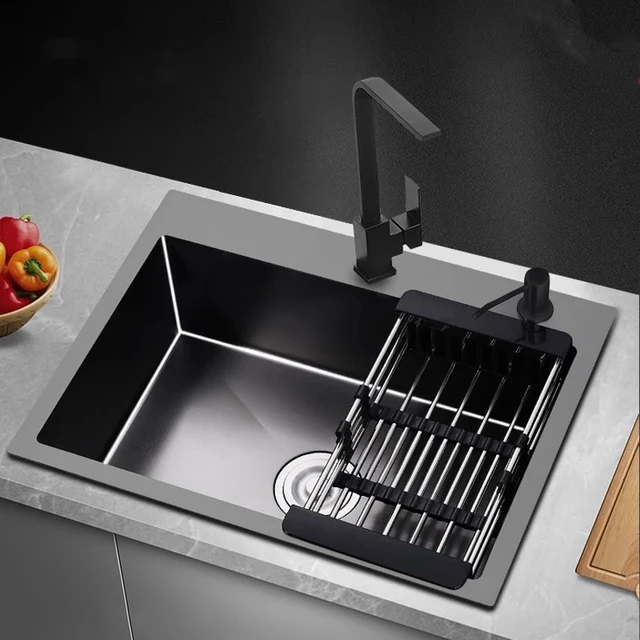 What Are Drop-In Stainless Steel Kitchen Sinks?
What Are Drop-In Stainless Steel Kitchen Sinks?
Definition
Drop-in stainless steel kitchen sinks, also known as top-mount sinks, are designed to fit into a pre-cut hole in your kitchen countertop. Their edges rest on the countertop, making installation straightforward.
Popularity
These sinks are favored for their sleek appearance and practicality. Stainless steel is a versatile material, and the drop-in design suits a wide range of kitchen styles.
Benefits of Drop-In Stainless Steel Kitchen Sinks
Durability
Stainless steel is renowned for its durability. It resists rust, stains, and heat, making it an ideal material for kitchen sinks. The material ensures that your sink will look new for many years.
Easy to Clean
Cleaning a stainless steel sink is simple. You can use common household cleaners without worrying about damage. Stainless steel does not harbor bacteria, providing a hygienic surface for food preparation.
Cost-Effective
Drop-in stainless steel sinks are generally more affordable than other types. They offer an excellent balance of cost and performance.
Stylish Appearance
The sleek, shiny surface of stainless steel gives any kitchen a modern and professional look. The clean lines of a drop-in sink complement various countertop materials and kitchen designs.
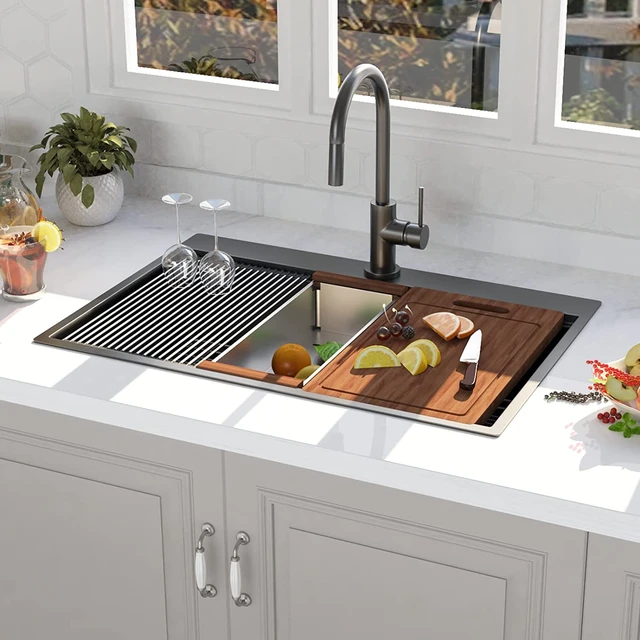 Installation Process
Installation Process
Tools and Materials Needed
Before installing a drop-in stainless steel kitchen sink, gather the necessary tools and materials: measuring tape, pencil, jigsaw, silicone sealant, clamps, and plumber’s putty.
Step-by-Step Installation
Step 1: Measure the Countertop
Ensure that the hole in your countertop matches the size of your sink. Measure twice to avoid mistakes.
Step 2: Cut the Hole
If the countertop does not have a pre-cut hole, use a jigsaw to cut one. Follow the measurements carefully.
Step 3: Apply Sealant
Apply a bead of silicone sealant around the underside edge of the sink. This will create a waterproof seal when the sink is set in place.
Step 4: Position the Sink
Lower the sink into the hole. Ensure it fits snugly and evenly.
Step 5: Secure the Sink
From underneath the countertop, use clamps to secure the sink in place. Tighten them to ensure a firm hold.
Step 6: Connect Plumbing
Attach the water supply lines and drain pipes. Use plumber’s putty to ensure a leak-free connection.
Step 7: Test for Leaks
Turn on the water and check for any leaks. If you find any, tighten the connections accordingly.
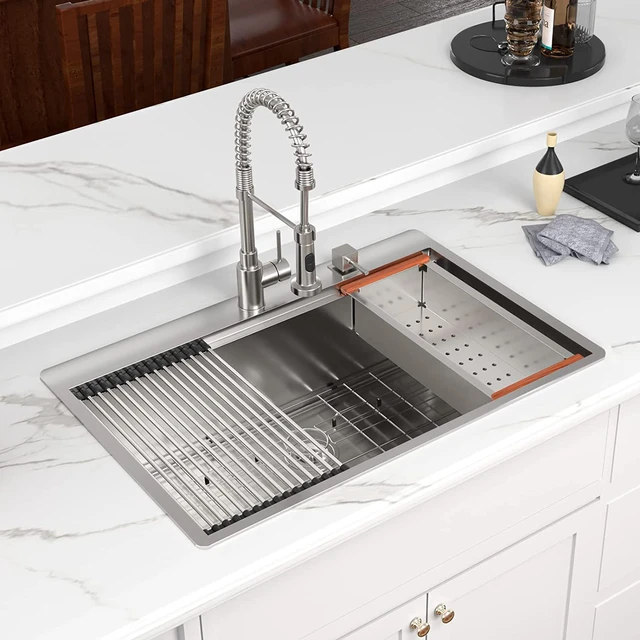 Maintenance Tips
Maintenance Tips
Regular Cleaning
Clean your sink regularly using mild soap and water. Avoid abrasive cleaners that can scratch the surface.
Preventing Stains and Scratches
Use a sink grid or mat to protect the bottom of the sink from scratches. Remove any staining agents like coffee or tea immediately.
Polishing
To keep your sink shiny, polish it with a stainless steel cleaner. Follow the grain of the steel to avoid streaks.
Addressing Rust
If rust spots appear, use a paste of baking soda and water to scrub them off gently. Stainless steel should not rust, so inspecting for underlying issues is essential.
Different Styles and Configurations
Single Bowl Sinks
Single bowl sinks offer ample space for washing large items. They are ideal for those who do a lot of cooking and cleaning.
Double Bowl Sinks
Double bowl designs allow you to perform multiple tasks simultaneously. For example, one bowl can be used for washing dishes while the other is for rinsing or prepping food.
Triple Bowl Sinks
Triple bowl sinks provide even more flexibility. They typically feature two larger bowls and a smaller central one. This design is excellent for busy kitchens.
Integrated Drainboard
Some drop-in stainless steel sinks come with an integrated drainboard. This feature is useful for drying dishes and preventing water from spilling onto the countertop.
Choosing the Right Sink for Your Kitchen
Size Considerations
Measure your countertop space to determine the correct sink size. Consider your kitchen activities and choose a size that accommodates your needs.
Gauge and Thickness
The thickness of stainless steel is measured in gauges. Lower gauge numbers indicate thicker steel. A 16 or 18 gauge sink is recommended for optimal durability and noise reduction.
Finish Options
Stainless steel sinks come in various finishes, such as brushed or satin. Choose one that matches your kitchen decor. Brushed finishes hide scratches better, while satin finishes offer a smoother look.
Additional Features
Look for additional features like sound-deadening pads or undercoatings. These reduce noise during use and enhance the overall experience.
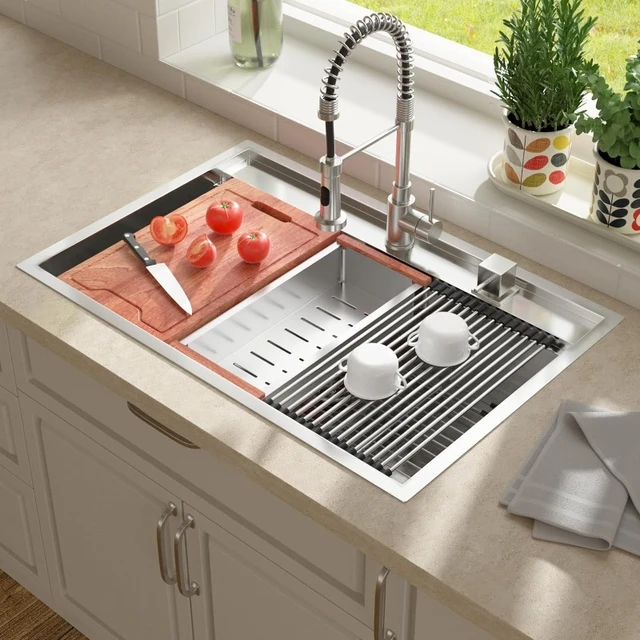 The trend for drop-in stainless steel kitchen sinks:
The trend for drop-in stainless steel kitchen sinks:
The trend for drop-in stainless steel kitchen sinks has been evolving in several interesting ways:
Design and Aesthetics:
Modern drop-in stainless steel sinks are emphasizing sleek and minimalist designs. Clean lines and an overall streamlined appearance are popular, catering to contemporary kitchen styles.
Material Quality:
There is a growing trend towards high-grade stainless steel, such as 16-gauge and 18-gauge steel, which offers durability, resistance to dents, and a more premium feel.
Finish Options:
Beyond the traditional polished finish, manufacturers are introducing various finishes like brushed, matte, and even textured surfaces that help to deter fingerprints and water spots, adding both functionality and aesthetic appeal.
Size and Configuration:
Larger, single-bowl sinks are gaining popularity, as they provide ample space for washing large pots and pans. Similarly, multi-bowl options with integrated accessories and additional features like prep sinks are also trending.
Sound and Thermal Insulation:
Enhanced sound-deadening pads and undercoating are now common features in high-quality drop-in sinks, reducing noise from dish washing and disposal unit operation. Some sinks also offer thermal insulation to maintain water temperature longer.
Integrated Accessories:
There is an increasing demand for sinks that come with integrated accessories such as cutting boards, colanders, drying racks, and bottom grids. These accessories enhance functionality and are designed to fit seamlessly into the sink, maximizing utility and workspace efficiency.
Ease of Installation:
Drop-in sinks are favored for their straightforward installation. Innovations in mounting systems and the availability of DIY-friendly designs are making it even easier for homeowners to install these sinks with minimal professional assistance.
Sustainability:
Eco-conscious consumers are looking for sinks made from recycled stainless steel or those that have been manufactured using environmentally friendly processes. Sustainability is becoming a significant consideration in many buying decisions.
Stay tuned to these trends to ensure you choose a drop-in stainless steel kitchen sink that not only meets your functional needs but also aligns with contemporary design preferences and technological advancements.
One of the significant trends in kitchen design is the rising popularity of drop-in stainless steel kitchen sinks. These sinks are favored for their timeless appeal and durability. Homeowners and designers alike appreciate the versatility that stainless steel offers, seamlessly fitting into various kitchen styles from modern to traditional.
A major trend is the focus on functionality and ease of maintenance. Stainless steel is resistant to stains, rust, and corrosion, making it a practical choice for busy kitchens. More recent designs feature noise-reducing technology, which minimizes the sound of running water and clattering dishes, enhancing the overall kitchen experience.
In terms of aesthetics, there’s a growing preference for sinks with a brushed or satin finish, offering a sleek and sophisticated look without compromising on durability. The finishes are also effective in concealing minor scratches and water spots, maintaining a pristine appearance over time.
Additionally, integrative features are becoming increasingly popular. Sinks with built-in accessories like cutting boards, colanders, and drying racks are highly sought after. These features maximize functionality and workspace, catering to the needs of modern home cooks who value convenience and efficiency.
Overall, drop-in stainless steel kitchen sinks continue to be a favored choice, driven by trends that emphasize durability, practicality, and modern design.
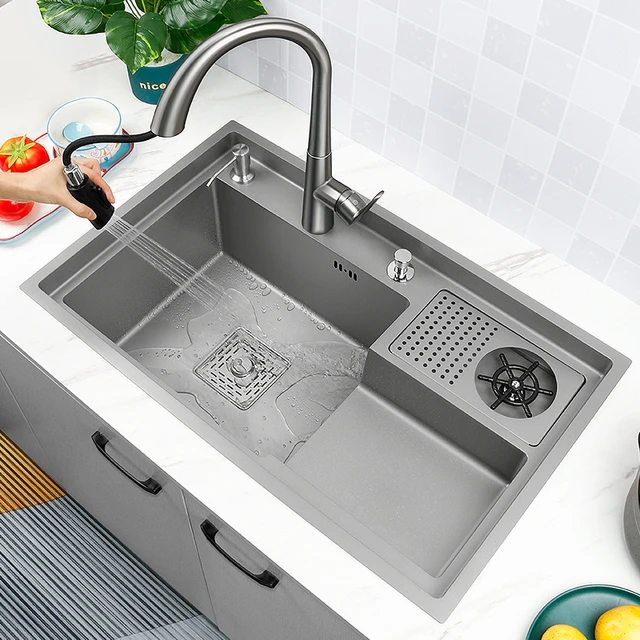 Conclusion
Conclusion
Drop-in stainless steel kitchen sinks offer a combination of style, durability, and functionality. They are an excellent choice for any modern kitchen. Whether you prefer a single, double, or triple bowl sink, there is a drop-in stainless steel sink that fits your needs. By following proper installation and maintenance practices, you can enjoy the benefits of your stainless steel sink for many years.
